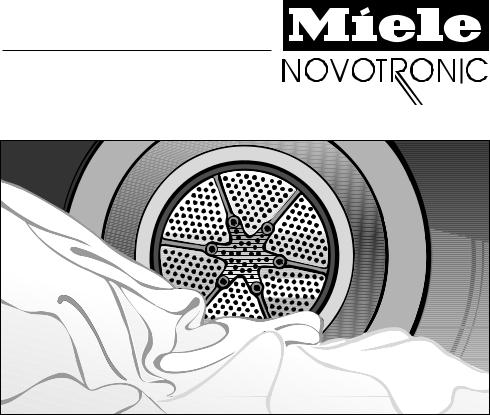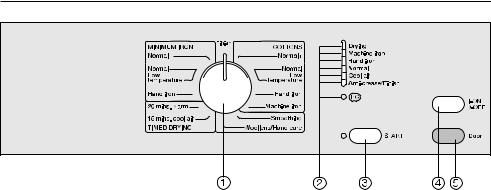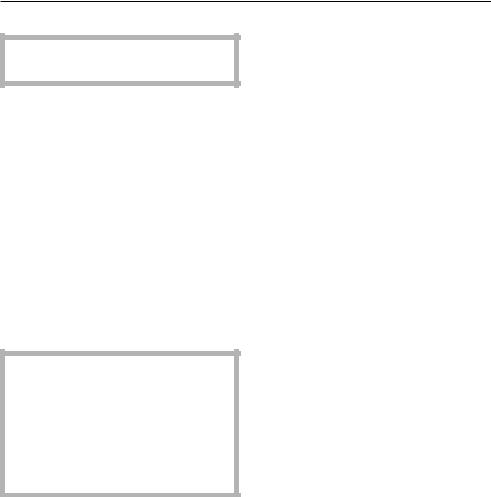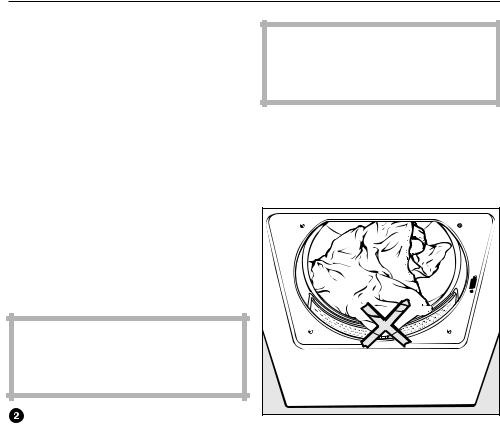Miele T 220 User Manual

Operating instructions for vented tumble dryer T 220
To avoid the risk of accidents or damage to the machine
it is essential to read these Operating instructions before
it is installed or used for the first time.
WO
M.-Nr. 05 538 260

Contents
Warning and Safety instructions . . . . . . . . . . . . . . . . . . . . . . . . . . . . . . . . . . . . . 4
Caring for the environment . . . . . . . . . . . . . . . . . . . . . . . . . . . . . . . . . . . . . . . . . . 8 Disposal of the packing material . . . . . . . . . . . . . . . . . . . . . . . . . . . . . . . . . . . . . . . 8 Disposal of your old appliance . . . . . . . . . . . . . . . . . . . . . . . . . . . . . . . . . . . . . . . . 8 Energy saving tips . . . . . . . . . . . . . . . . . . . . . . . . . . . . . . . . . . . . . . . . . . . . . . . . . . 8
Control panel . . . . . . . . . . . . . . . . . . . . . . . . . . . . . . . . . . . . . . . . . . . . . . . . . . . . . 9
Notes on laundry care . . . . . . . . . . . . . . . . . . . . . . . . . . . . . . . . . . . . . . . . . . . . 10
Programme chart . . . . . . . . . . . . . . . . . . . . . . . . . . . . . . . . . . . . . . . . . . . . . . . . . 11
How to dry correctly . . . . . . . . . . . . . . . . . . . . . . . . . . . . . . . . . . . . . . . . . . . . . . 14 A Prepare the laundry. . . . . . . . . . . . . . . . . . . . . . . . . . . . . . . . . . . . . . . . . . . . . . 14 B Load the drum and switch on the dryer . . . . . . . . . . . . . . . . . . . . . . . . . . . . . . 14 C Select a programme . . . . . . . . . . . . . . . . . . . . . . . . . . . . . . . . . . . . . . . . . . . . . 15 D Start the programme . . . . . . . . . . . . . . . . . . . . . . . . . . . . . . . . . . . . . . . . . . . . . 15
Selecting a different programme . . . . . . . . . . . . . . . . . . . . . . . . . . . . . . . . . . . 16 Interrupting a programme. . . . . . . . . . . . . . . . . . . . . . . . . . . . . . . . . . . . . . . . . 16 Adding or removing items . . . . . . . . . . . . . . . . . . . . . . . . . . . . . . . . . . . . . . . . 16 To cancel a programme . . . . . . . . . . . . . . . . . . . . . . . . . . . . . . . . . . . . . . . . . . 16 E At the end of a programme . . . . . . . . . . . . . . . . . . . . . . . . . . . . . . . . . . . . . . . . 16
Cleaning and care . . . . . . . . . . . . . . . . . . . . . . . . . . . . . . . . . . . . . . . . . . . . . . . . 17 Cleaning the fluff filter . . . . . . . . . . . . . . . . . . . . . . . . . . . . . . . . . . . . . . . . . . . . . . 17 Tumble dryer . . . . . . . . . . . . . . . . . . . . . . . . . . . . . . . . . . . . . . . . . . . . . . . . . . . . . 17
Problem solving guide. . . . . . . . . . . . . . . . . . . . . . . . . . . . . . . . . . . . . . . . . . . . . 18 After sales service . . . . . . . . . . . . . . . . . . . . . . . . . . . . . . . . . . . . . . . . . . . . . . . . . 23 Repairs . . . . . . . . . . . . . . . . . . . . . . . . . . . . . . . . . . . . . . . . . . . . . . . . . . . . . . . 23 PC indicator lamp (Interface for service technicians) . . . . . . . . . . . . . . . . . . . 23
2

Contents
Installation . . . . . . . . . . . . . . . . . . . . . . . . . . . . . . . . . . . . . . . . . . . . . . . . . . . . . . 24 Front view. . . . . . . . . . . . . . . . . . . . . . . . . . . . . . . . . . . . . . . . . . . . . . . . . . . . . . . . 24 Installation . . . . . . . . . . . . . . . . . . . . . . . . . . . . . . . . . . . . . . . . . . . . . . . . . . . . . . . 25 Transporting the machine to its installation site . . . . . . . . . . . . . . . . . . . . . . . . 25 Aligning the machine . . . . . . . . . . . . . . . . . . . . . . . . . . . . . . . . . . . . . . . . . . . . 25 Installation site . . . . . . . . . . . . . . . . . . . . . . . . . . . . . . . . . . . . . . . . . . . . . . . . . . . . 26 Building under a continuous worktop / in a row of kitchen units . . . . . . . . . . . 26 Replacing the lid. . . . . . . . . . . . . . . . . . . . . . . . . . . . . . . . . . . . . . . . . . . . . . . . 26 Washer-dryer stack. . . . . . . . . . . . . . . . . . . . . . . . . . . . . . . . . . . . . . . . . . . . . . 26 Electrical connection . . . . . . . . . . . . . . . . . . . . . . . . . . . . . . . . . . . . . . . . . . . . . . . 27
Installation - venting . . . . . . . . . . . . . . . . . . . . . . . . . . . . . . . . . . . . . . . . . . . . . . 28 General . . . . . . . . . . . . . . . . . . . . . . . . . . . . . . . . . . . . . . . . . . . . . . . . . . . . . . . . . 28 Calculating the effective duct length: . . . . . . . . . . . . . . . . . . . . . . . . . . . . . . . . . . 29 Installation to the rear, left or right hand side of the machine . . . . . . . . . . . . . . . . 30 Venting systems overview . . . . . . . . . . . . . . . . . . . . . . . . . . . . . . . . . . . . . . . . . . . 31 a Venting system with Flexible ducting hose . . . . . . . . . . . . . . . . . . . . . . . . . . . . 31 b Venting system with plastic piping . . . . . . . . . . . . . . . . . . . . . . . . . . . . . . . . . . 33 c Connecting directly to a wall vent . . . . . . . . . . . . . . . . . . . . . . . . . . . . . . . . . . 34 d Main venting duct . . . . . . . . . . . . . . . . . . . . . . . . . . . . . . . . . . . . . . . . . . . . . . . 35 Washer dryer stack . . . . . . . . . . . . . . . . . . . . . . . . . . . . . . . . . . . . . . . . . . . . . . . . 36
Consumption data . . . . . . . . . . . . . . . . . . . . . . . . . . . . . . . . . . . . . . . . . . . . . . . . 37
Technical data . . . . . . . . . . . . . . . . . . . . . . . . . . . . . . . . . . . . . . . . . . . . . . . . . . . 38
Programmable functions. . . . . . . . . . . . . . . . . . . . . . . . . . . . . . . . . . . . . . . . . . . 40 Increased drying level in the COTTONS programmes . . . . . . . . . . . . . . . . . . . . . 40 Increased drying level in the MINIMUM IRON programmes . . . . . . . . . . . . . . . . . 41 Buzzer . . . . . . . . . . . . . . . . . . . . . . . . . . . . . . . . . . . . . . . . . . . . . . . . . . . . . . . . . . 42
3

Warning and Safety instructions
Read the operating instructions carefully before using this appliance for the first time. They contain important information about the safety, use and maintenance of the appliance. This way you will avoid the risk of accidents and damage to the appliance.
Keep these operating instructions in a safe place and ensure that new users are familiar with the content. Pass them on to any future owner of the machine.
Correct use
The tumble dryer is only intended for drying fabrics which have been
washed in a water solution, marked on the manufacturer’s wash care label as being suitable for tumble drying.
Any other applications may be dangerous. The manufacturer is not liable for damage resulting from improper use or operation.
Technical safety
Before setting up the machine check it for any externally visible
damage. Do not install or use a damaged machine.
Before connecting the machine, ensure that the connection data on
the data plate (fusing, voltage and frequency) matches the mains electricity supply. If in any doubt, consult a qualified electrician.
The electrical safety of this machine can only be guaranteed
when continuity is complete between
the appliance and an effective earthing system which complies with local and national regulations. It is most important that this basic safety requirement is regularly tested by a qualified electrician. The manufacturer cannot be held responsible for the consequences of an inadequate earthing system (e.g. electric shock).
Do not connect the machine to the mains electricity supply by an ex-
tension lead. Extension leads do not guarantee the required safety of the machine (e.g. danger or overheating).
The machine is built in accordance with current safety requirements.
Unauthorised repairs could result in unforeseen dangers for the user, for which the manufacturer cannot accept responsibility. Repairs should only be undertaken by a Miele approved engineer.
Ensure current is not supplied to the appliance while maintenance or repair work is being carried out.
Faulty components must only be exchanged for Miele original spare
parts. Only when these parts are fitted can the safety standards of the machine be guaranteed.
If the appliance is supplied from a cord extension set or electrical por-
table outlet device the cord extension set or electrical portable outlet device should be positioned so it is not subject to splashing or ingress of moisture.
4

Warning and Safety instructions
If the mains cable becomes damaged it must be replaced with a
Miele original cable.
In the event of a fault or for cleaning purposes, the machine is only completely isolated from the electricity
supply when:
–it is switched off at the wall socket and the plug is withdrawn, or
–it is switched off at the mains, or
–the mains fuse is withdrawn.
Operation
This equipment is not designed for maritime use or for use in mobile
installations such as caravans, aircraft etc. However, it may be suitable for such usage subject to a risk assessment of the installation being carried out by a suitably qualified engineer.
Young children should be supervised to ensure that they do not
play with the appliance.
Do not let small children play with the machine or its controls. Super-
vise its use by the elderly or infirm.
This dryer must not be:
–connected to a chimney or vent flue which is in use.
–used without exhaust ducting.
–used without the fluff filter in place or if the fluff filter is damaged in any way.
Check all parts of the extraction system on a regular basis (e.g. wall
vent, external grille, bends in the ducting etc.) and make sure they are all
free of any hindrance. A build-up of fluff will prevent a free-flow of air through the system. If the dryer is to be connected to an existing ducting system this must be checked for suitability beforehand.
Adequate ventilation is essential, especially where another appli-
ance which also uses the room air (eg gas, oil or coal fired heater, continuous flow or other water heater) is installed in the same or an adjacent room. To ensure safe operation, and to prevent gases given off by these appliances being drawn back into the room, an underpressure of 0.04 mbar is the maximum permissible. Ventilation can be maintained by air inlets which cannot be blocked, in windows, doors and outside wall vents, or by an automatic window opening arrangement when the tumble dryer is switched on. If in doubt, the advice of a competent builder, or for gas, a gas fitter must be sought.
The exhaust air must not be vented into a chimney or vent flue which is
in use, nor should it be connnected to ducting which ventilates rooms with fireplaces. It would be dangerous if smoke or exhaust fumes were drawn back into the room.
Do not install the machine in a room where the temperature may
drop down to or below freezing. At very cold temperatures the machine may be difficult to start.
Always keep the area around the machine free of dust and fluff.
5

Warning and Safety instructions
Always close the door after use. This way you will avoid the danger
of:
–anyone sitting or leaning on the door, which can cause the machine to tip up,
–children climbing onto or into the dryer or hiding things in it.
There is danger of fire with fabrics which:
–contain a large proportion of rubber, foam rubber or rubber like materials.
–have been treated with inflammable cleaning agents.
–have been splashed with hair lacquer, hair spray, nail varnish remover or similar substances.
–which contain padding or fillings (e.g. pillows, jackets). If these were damaged the filling could leak with the risk of igniting in the dryer.
–are soiled with oil or grease.
In areas which may be subject to infestation by cockroaches or other
vermin, pay particular attention to keeping the appliance and its surroundings in a clean condition at all times. Any damage which may be caused by cockroaches or other vermin will not be covered by the appliance guarantee.
To minimize the risk of fire in a tumble dryer, the following
should be observed:
–Items that have been spotted or soaked with vegetable or cooking oil constitute a fire hazard and should not be placed in a tumble dryer.
Oil-affected items can ignite spontaneously, especially when exposed to heat sources such as in a tumble dryer. The items become warm, causing an oxidation reaction in the oil. Oxidation creates heat. If the heat cannot escape, the items can become hot enough to catch fire. Pilling, stacking or storing oil-af- fected items can prevent heat from escaping and so create a fire hazard.
If it is unavoidable that fabrics that contain vegetable or cooking oil or have been contaminated by hair care products be placed in a tumble dryer they should first be washed in hot water with extra detergent - this will reduce, but not eliminate, the hazard. The "cool down" cycle of tumble dryers should be used to reduce the temperature of the items. They should not be removed from the tumble dryer or piled or stacked while hot.
6

Warning and Safety instructions
–Items that have been previously cleaned in, washed in, soaked in or spotted with petrol/gasoline, dry-cleaning solvents or other flammable or explosive substances should not be placed in a tumble dryer.
Highly flammable substances commonly used in a domestic environments include acetone, denatured alcohol, petrol/gasoline, kerosene, spot removers (some brands), turpentine, waxes and wax removers.
–Items containing foam rubber (also known as latex foam) or similarly textured rubber like materials should not be dried in a tumble dryer on a heat setting.
Foam rubber materials can, when heated, produce fire by spontaneous combustion.
–Fabric softeners or similar products should not be used in a tumble dryer to eliminate the effects of static electricity unless this practice is specifically recommended by the manufacturer of the fabric softener or product.
–Undergarments that contain metal reinforcements should not be placed in a tumble dryer.
Damage to the tumble dryer can result if metal reinforcements come loose during drying. When available a drying rack could be used for such items.
–Plastic articles such as shower caps or babies’ waterproof napkin covers should not be placed in a tumble dryer.
–Rubber-backed articles, clothes fitted with foam rubber pads, pillows, galoshes and rubber-coated tennis shoes should not be placed in a tumble dryer.
Using accessories
Accessory parts may only be fitted when expressly approved by Miele.
If other parts are used, guarantee, performance and product liability claims may be invalidated.
7

Caring for the environment
Disposal of the packing material
The transport and protective packing has been selected from materials which are environmentally friendly for disposal and can normally be recycled.
Ensure that any plastic wrappings, bags etc. are disposed of safely and kept out of the reach of babies and young children. Danger of suffocation!
Rather than just throwing these materials away, please ensure they are offered for recycling.
Disposal of your old appliance
Old machines contain materials which can be reclaimed or recycled. Please contact your dealer, your local waste collection centre or scrap merchant about potential recycling schemes.
Before discarding an old machine unplug it and render the plug useless. Cut off the cable directly behind the appliance to prevent misuse. This should be done by a competent person.
Ensure that the machine presents no danger to children while being stored for disposal.
Energy saving tips
^Make sure that your laundry is thoroughly spun before drying.
The higher the spin, the greater the savings that can be made in energy and time during drying.
^Load according to the optimum amount of laundry recommended for the programme being used (see "Programme chart").
Underloading is uneconomical. Overloading gives a poorer quality of drying and may cause unnecessary creasing.
^To avoid unecessarily long drying times and high consumption of energy:
–Make sure the room in which the dryer is located is well ventilated.
–Make sure the fluff filter is clean before using the dryer.
–Check all parts of the ventilation system on a regular basis and remove any build up of fluff etc.
^The vent ducting should be as short, straight and smooth as possible to minimise any resistance to the air throughflow.
This helps to reduce running times and energy consumption levels.
8

Control panel
aProgramme selector
The programme selector can be turned clockwise or anti-clockwise.
bProgramme sequence and check lamps
cSTART button
Press the Start button to start a programme.
The Start indicator lamp will flash as soon as a programme can be started. It lights up constantly once the programme has started.
dI-On/0-Off button
To switch the appliance on or off / to interrupt a programme.
eDoor button
to open the door / to cancel a programme.
Pressing this button will open the door even when the appliance is switched off at the mains.
If the appliance is switched on at the mains and the door is opened the drum lighting will come on. It will go out a few minutes later to save energy.
9

Notes on laundry care
Wash care labels
Before drying check the drying symbol on the wash care label.
Significance of symbols:
qDry at normal temperature rDry at low temperature
sDo not tumble dry
If no symbol is featured, dry at your own risk applying the following principles:
Cotton and minimum iron items should be dried using the appropriate programme for the degree of drying required. See programme chart.
For delicates and fabrics with the following wash care label r you can also select the Low temperature option.
Never overload the drum. Always observe the maximum recommended loads given in the "Programme chart". Overloading can cause unnecessary wear and tear to the laundry, give a disappointing drying result and cause more creasing.
Tips on drying
Woollens and wool blends tend to become matted and shrink if dried in a tumble dryer. They can, however, be partially dried using the Woollens hand care programme.
Items filled with down.
The fine fabric interior of these items may shrink depending on the quality. These items can be partially dried using the Smoothing programme.
Pure linen should only be machine dried if specified as suitable by the manufacturer on the wash care label, as the surface of the fabric may otherwise "roughen". These items can be partially dried using the "Smoothing" programme.
Woven and loopknit materials (e.g. T-shirts, knitted garments) have a tendency to shrink, depending on their quality and this is made worse by over-drying. When purchasing these garments it is advisable to take their shrinkage properties into account.
Minimum iron fabrics and 100% cotton shirts or blouses tend to crease more, the larger the load being dried, particulary when the weave of the fabric is very fine. Reduce the load or use the Special care Minimum iron - Hand iron programme. If this is unsatisfactory use the "Smoothing" setting, then hang the garments on a hanger to dry.
Starched laundry can be dried in the tumble dryer. In order to achieve the usual finish, double the amount of starch should be used.
New dark coloured garments should be dried separately from light coloured garments to avoid the danger of colours running.
10
|
|
Programme chart |
|
|
|
|
|
|
Programmes |
Fabric type |
Special notes |
COTTONS |
|
maximum load: |
Drying levels |
|
5 kg (1) |
Normal+ |
Single and multi-layered fab- |
- |
|
rics, e.g. mixed load of cot- |
|
|
ton fabrics (e.g. towelling, |
|
|
jerseywear). |
|
Normal (2) |
Load of similar fabrics (jer- |
If laundry is still too damp, |
|
sey wear, flannelette sheets, |
then: |
|
towelling). |
- finish drying using Timed |
|
|
drying Warm air. |
|
|
- use the Normal+ |
|
|
programme next time. |
Low temperature |
For drying delicate fabrics |
Laundry is dried using the |
|
with the symbol r (e.g. |
Normal programme, but at a |
|
acrylic garments). |
lower temperature. |
Hand iron (2) |
Cotton or linen fabrics (e.g. |
- |
|
table linen, bed linen, |
|
|
starched laundry etc.). |
|
Machine iron |
Cotton or linen fabrics, in- |
The laundry should be rolled |
|
cluding starched laundry for |
up to prevent it from drying |
|
machine ironing. |
out before it can be ironed. |
(1)Weight of dry laundry
(2)Note for test institutes: Programme setting for testing according to EN 61121 standard
11

Programme chart
Programmes |
Fabric type |
Special notes |
MINIMUM IRON |
|
maximum load: |
Drying levels |
|
2.5 kg (1) |
Normal+ |
Minimum iron items which are |
Spin minimum iron fabrics for |
|
made of synthetic or blended |
at least 30 seconds in the |
|
fabrics (e.g. pullovers, |
washing machine before dry- |
|
dresses, trousers) which are |
ing them. |
|
not dried adequately in the |
|
|
Normal programme. |
|
Normal (2) |
Minimum iron shirts, table |
Spin minimum iron fabrics for |
|
cloths etc. made of mixed |
at least 30 seconds in the |
|
fibres, e.g. cottons / synthet- |
washing machine before dry- |
|
ics. |
ing them. |
Low temperature |
For drying delicate fabrics |
Laundry is dried using the |
|
with the symbol r (e.g. |
Normal programme, but at a |
|
acrylic garments). |
lower temperature. |
|
|
Spin minimum iron fabrics for |
|
|
at least 30 seconds in the |
|
|
washing machine before dry- |
|
|
ing them. |
Hand iron |
Minimum iron shirts, table |
Spin minimum iron fabrics for |
|
cloths etc. made of mixed |
at least 30 seconds in the |
|
fibres, e.g. cottons / synthet- |
washing machine before dry- |
|
ics, which are still to be hand |
ing them. |
|
ironed. |
For extra special care of deli- |
|
|
cate fabrics and to reduce |
|
|
creasing even more, reduce |
|
|
the load to 1 kg. |
(1)Weight of dry laundry
(2)Note for test institutes: Programme setting for testing according to EN 61121 standard
12
|
|
Programme chart |
|
|
|
|
|
|
|
|
|
Programme |
Fabric type |
Special notes |
|
Special care programmes |
|
||
Woollens |
|
maximum load: 2 kg (1) |
|
hand care |
|
|
|
Woollen fabrics |
To refresh and fluff up woollen gar- |
||
|
|||
|
|
ments quickly. Remove garments im- |
|
|
|
mediately at the end of the |
|
|
|
programme. Do not repeat. |
|
|
|
Woollen fabrics are not dried com- |
|
|
|
pletely by this programme. |
|
|
|
|
|
Smoothing |
|
maximum load: 2.5 kg (1) |
|
|
Cottons and linen fabrics. |
Smooths out creasing caused during |
|
|
Minimum iron items made |
the spin cycle in the washing ma- |
|
|
of cotton, blended fabrics |
chine. |
|
|
or synthetics, e.g. cotton |
Fabrics are not completely dried in |
|
|
trousers, shirts. |
this programme. |
|
|
|
Remove garments immediately at the |
|
|
|
end of the programme and place on |
|
|
|
a line or hangers to dry. |
|
|
|
|
|
TIMED DRYING |
maximum load: 5 kg (1) |
||
Warm air |
Individual items |
- |
|
|
(e.g. bathing costumes, |
|
|
|
bath towels, tea-towels). |
|
|
|
Multi-layered fabric whose |
|
|
|
layers have different drying |
|
|
|
characteristics. |
|
|
|
|
|
|
Cool air |
Items which are to be aired |
- |
|
|
only. |
|
|
|
|
|
|
(1) Weight of dry laundry
13

How to dry correctly
 Prepare the laundry
Prepare the laundry
^As far as possible, sort laundry for:
-the type of fibre or weave,
-the degree of dryness required,
-similar size of items,
-the moisture content after
spinning.
This will help towards achieving an even drying result.
Fasten duvet covers etc. to prevent small items from being rolled up inside them.
Do up zips, hooks and eyes etc.
Tie fabric belts, apron strings.
Sew in or remove underwiring from bras.
Make sure there is no detergent dispenser ball etc. in with the laundry, as this could melt and damage the machine and the laundry.
Load the drum
and switch on the dryer
^Press the door button and open the door.
^Load the laundry loosely into the drum.
Do not overload the drum. Overloading can cause unecessary wear and tear to the laundry and give a disappointing drying result.
See the "Programme chart" for maximum recommended loads.
^Before closing the door check that the fluff filter is correctly positioned in the door.
When closing the door make sure items of laundry cannot be trapped by the door, as this will cause damage to the laundry.
^Shut the door either with a gentle swing or lean against it and push it shut.
^Switch the dryer on by pressing the "l-On/0-Off" button.
14
